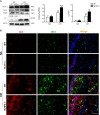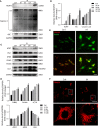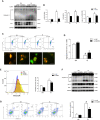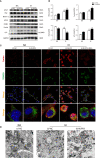NLRP3 Deficiency Protects Against Intermittent Hypoxia-Induced Neuroinflammation and Mitochondrial ROS by Promoting the PINK1-Parkin Pathway of Mitophagy in a Murine Model of Sleep Apnea
- PMID: 33717152
- PMCID: PMC7943742
- DOI: 10.3389/fimmu.2021.628168
NLRP3 Deficiency Protects Against Intermittent Hypoxia-Induced Neuroinflammation and Mitochondrial ROS by Promoting the PINK1-Parkin Pathway of Mitophagy in a Murine Model of Sleep Apnea
Abstract
Obstructive sleep apnea (OSA) associated neurocognitive impairment is mainly caused by chronic intermittent hypoxia (CIH)-triggered neuroinflammation and oxidative stress. Previous study has demonstrated that mitochondrial reactive oxygen species (mtROS) was pivotal for hypoxia-related tissue injury. As a cytosolic multiprotein complex that participates in various inflammatory and neurodegenerative diseases, NLRP3 inflammasome could be activated by mtROS and thereby affected by the mitochondria-selective autophagy. However, the role of NLRP3 and possible mitophagy mechanism in CIH-elicited neuroinflammation remain to be elucidated. Compared with wild-type mice, NLRP3 deficiency protected them from CIH-induced neuronal damage, as indicated by the restoration of fear-conditioning test results and amelioration of neuron apoptosis. In addition, NLRP3 knockout mice displayed the mitigated microglia activation that elicited by CIH, concomitantly with elimination of damaged mitochondria and reduction of oxidative stress levels (malondialdehyde and superoxide dismutase). Elevated LC3 and beclin1 expressions were remarkably observed in CIH group. In vitro experiments, intermittent hypoxia (IH) significantly facilitated mitophagy induction and NLRP3 inflammasome activation in microglial (BV2) cells. Moreover, IH enhanced the accumulation of damaged mitochondria, increased mitochondrial depolarization and augmented mtROS release. Consistently, NLRP3 deletion elicited a protective phenotype against IH through enhancement of Parkin-mediated mitophagy. Furthermore, Parkin deletion or pretreated with 3MA (autophagy inhibitor) exacerbated these detrimental actions of IH, which was accompanied with NLRP3 inflammasome activation. These results revealed NLRP3 deficiency acted as a protective promotor through enhancing Parkin-depended mitophagy in CIH-induced neuroinflammation. Thus, NLRP3 gene knockout or pharmacological blockage could be as a potential therapeutic strategy for OSA-associated neurocognitive impairment.
Keywords: neuroinflammation; nucleotide‐binding domain like receptor protein 3 (NLRP3); obstructive sleep apnea (OSA); parkin-mediated mitophagy; reactive oxygen species (ROS).
Copyright © 2021 Wu, Gong, Xie, Gu, Wang, Liu and Li.
Conflict of interest statement
The authors declare that the research was conducted in the absence of any commercial or financial relationships that could be construed as a potential conflict of interest.
Figures








Similar articles
-
PINK1-parkin pathway of mitophagy protects against contrast-induced acute kidney injury via decreasing mitochondrial ROS and NLRP3 inflammasome activation.Redox Biol. 2019 Sep;26:101254. doi: 10.1016/j.redox.2019.101254. Epub 2019 Jun 11. Redox Biol. 2019. PMID: 31229841 Free PMC article.
-
Heterozygous SOD2 deletion deteriorated chronic intermittent hypoxia-induced lung inflammation and vascular remodeling through mtROS-NLRP3 signaling pathway.Acta Pharmacol Sin. 2020 Sep;41(9):1197-1207. doi: 10.1038/s41401-019-0349-y. Epub 2020 Feb 17. Acta Pharmacol Sin. 2020. PMID: 32066884 Free PMC article.
-
NLRP3 inflammasome mediates chronic intermittent hypoxia-induced renal injury implication of the microRNA-155/FOXO3a signaling pathway.J Cell Physiol. 2018 Dec;233(12):9404-9415. doi: 10.1002/jcp.26784. Epub 2018 Jun 28. J Cell Physiol. 2018. PMID: 29953588
-
Mitochondrial dysfunction as a driver of NLRP3 inflammasome activation and its modulation through mitophagy for potential therapeutics.Int J Biochem Cell Biol. 2021 Jul;136:106013. doi: 10.1016/j.biocel.2021.106013. Epub 2021 May 19. Int J Biochem Cell Biol. 2021. PMID: 34022434 Review.
-
Polygala saponins inhibit NLRP3 inflammasome-mediated neuroinflammation via SHP-2-Mediated mitophagy.Free Radic Biol Med. 2022 Feb 1;179:76-94. doi: 10.1016/j.freeradbiomed.2021.12.263. Epub 2021 Dec 20. Free Radic Biol Med. 2022. PMID: 34933095 Review.
Cited by
-
Potential mechanism of impaired perceptual reasoning in children with obstructive sleep apnea syndrome: topological analysis of brain white matter network employing graph theory.Brain Imaging Behav. 2025 Apr;19(2):543-555. doi: 10.1007/s11682-025-00988-w. Epub 2025 Mar 7. Brain Imaging Behav. 2025. PMID: 40053277
-
Mitophagy-associated programmed neuronal death and neuroinflammation.Front Immunol. 2024 Oct 2;15:1460286. doi: 10.3389/fimmu.2024.1460286. eCollection 2024. Front Immunol. 2024. PMID: 39416788 Free PMC article. Review.
-
Intermittent hypoxia treatments cause cellular priming in human microglia.J Cell Mol Med. 2023 Mar;27(6):819-830. doi: 10.1111/jcmm.17682. Epub 2023 Feb 23. J Cell Mol Med. 2023. PMID: 36824025 Free PMC article.
-
The Role of HDAC6 in Autophagy and NLRP3 Inflammasome.Front Immunol. 2021 Oct 27;12:763831. doi: 10.3389/fimmu.2021.763831. eCollection 2021. Front Immunol. 2021. PMID: 34777380 Free PMC article. Review.
-
The common link between sleep apnea syndrome and osteoarthritis: a literature review.Front Med (Lausanne). 2024 Aug 21;11:1401309. doi: 10.3389/fmed.2024.1401309. eCollection 2024. Front Med (Lausanne). 2024. PMID: 39234045 Free PMC article. Review.
References
Publication types
MeSH terms
Substances
LinkOut - more resources
Full Text Sources
Other Literature Sources
Medical
Research Materials

